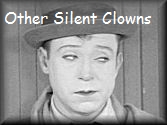THE STRONG MAN
(1926)With Harry Langdon, Priscilla Bonner, Gertrude Astor, William V. Mong, Robert McKim, Arthur Thalasso
Directed by Frank Capra
Silent, Black and White
Reviewed by JB
 I wonder if Walter Kerr was right when he said that in order to
understand Harry Langdon, you had to be fully immersed in silent comedy
- essentially, you had to live in the teens and twenties of the 20th
century and have had silent comedy a part of your daily life. THE
STRONG MAN was the first Langdon feature I had ever
seen, and he is certainly difficult to categorize. He was like
Chaplin, only not really. His style resembled Keaton's, but not
quite. He was nothing like Harold Lloyd, so much so he is almost
the Anti-Harold, except like Harold's screen character, he was
exceedingly nice. The comedian he reminds me of the most is
Stan
Laurel, but the "Stan" character, the one who so successfully partnered
with Oliver Hardy, came later, so it is really Laurel who resembled
Langdon, both physically and in style. The blank look, the slow
blink, the tendency to not know what to do with one's hands - I think
it is undeniable that Laurel borrowed from Langdon, but like all great
comedians, Laurel made the borrowed bits his own.
I wonder if Walter Kerr was right when he said that in order to
understand Harry Langdon, you had to be fully immersed in silent comedy
- essentially, you had to live in the teens and twenties of the 20th
century and have had silent comedy a part of your daily life. THE
STRONG MAN was the first Langdon feature I had ever
seen, and he is certainly difficult to categorize. He was like
Chaplin, only not really. His style resembled Keaton's, but not
quite. He was nothing like Harold Lloyd, so much so he is almost
the Anti-Harold, except like Harold's screen character, he was
exceedingly nice. The comedian he reminds me of the most is
Stan
Laurel, but the "Stan" character, the one who so successfully partnered
with Oliver Hardy, came later, so it is really Laurel who resembled
Langdon, both physically and in style. The blank look, the slow
blink, the tendency to not know what to do with one's hands - I think
it is undeniable that Laurel borrowed from Langdon, but like all great
comedians, Laurel made the borrowed bits his own.
His contemporaries were certainly aware of him. There is a fine routine in THE STRONG MAN where Langdon has to carry an unconscious woman up the stairs and into her room. Keaton took this basic idea, turned it into a classic routine in SPITE MARRIAGE and used the same routine the rest of his life, in films (SPEAK EASILY, with Thelma Todd) and in his later live acts with his wife Eleanor.
But perhaps Walter Kerr was right: Langdon exists as a commentary on silent comedy. In the same way that Laurel and Hardy took all that went before them and showed us how absurdly silly it all was by explaining each joke, Langdon, as Walter Kerr said, added a comma to the language of comedy, functioning as the hesitant pause in the gags. Sometimes there is no gag, just Langdon pausing in the action, unable to make up his mind what to do. Most comedians had a memorable walk - Chaplin's shuffle, Groucho's stoop, Hardy's graceful fox trot. Langdon's natural walk seemed to be two and a half step forwards, one pause, and then a reverse in direction - repeat as necessary. There is another scene in a bus where Langdon, suffering from a cold, accidentally puts limburger cheese on his chest instead of a medicinal rub. There are hardly any gags in the sequence, just Harry being Harry. Later, it takes him three minutes to work up the nerve to give the love of his life a kiss on the hand. In the meantime, again, no gags, just Langdon working up his nerve. There is a lot to be said for minimalist comedy - watching Stan Laurel eating an egg or seniors Bob Elliot and Ray Goulding sitting in chairs singing "Do You Think I'm Sexy" is funny because the men involved in these activities were intrinsically funny in themselves.
And Harry Langdon is intrinsically funny too, but he seems to have a very narrow range of comic reactions. There's the finger to the mouth, like a scared little boy caught doing something bad; the "which way do I go" run, going this way, than that way, than this way again. He was not an athlete like Lloyd or Keaton, so some of his routines have that obvious cut where a stuntman falls and then, suddenly in the same shot, it is Harry again.
Still, THE STRONG MAN holds up as
a well-made, intermittently amusing silent comedy. Some
people who completely "get" Harry today think it is one of the best
ever made. I just don't know how many people can completely get
Langdon today.  - JB
- JB
Other Silent Clowns The Age of Comedy
WHAT I REALLY WANT TO DO IS DIRECT CLASSICS
THE STRONG MAN was the first feature directed by Frank Capra, who helped Langdon develop his character and comic style. Capra would go on to direct such movies as IT HAPPENED ONE NIGHT, MR. SMITH GOES TO WASHINGTON and IT'S A WONDERFUL LIFE.


